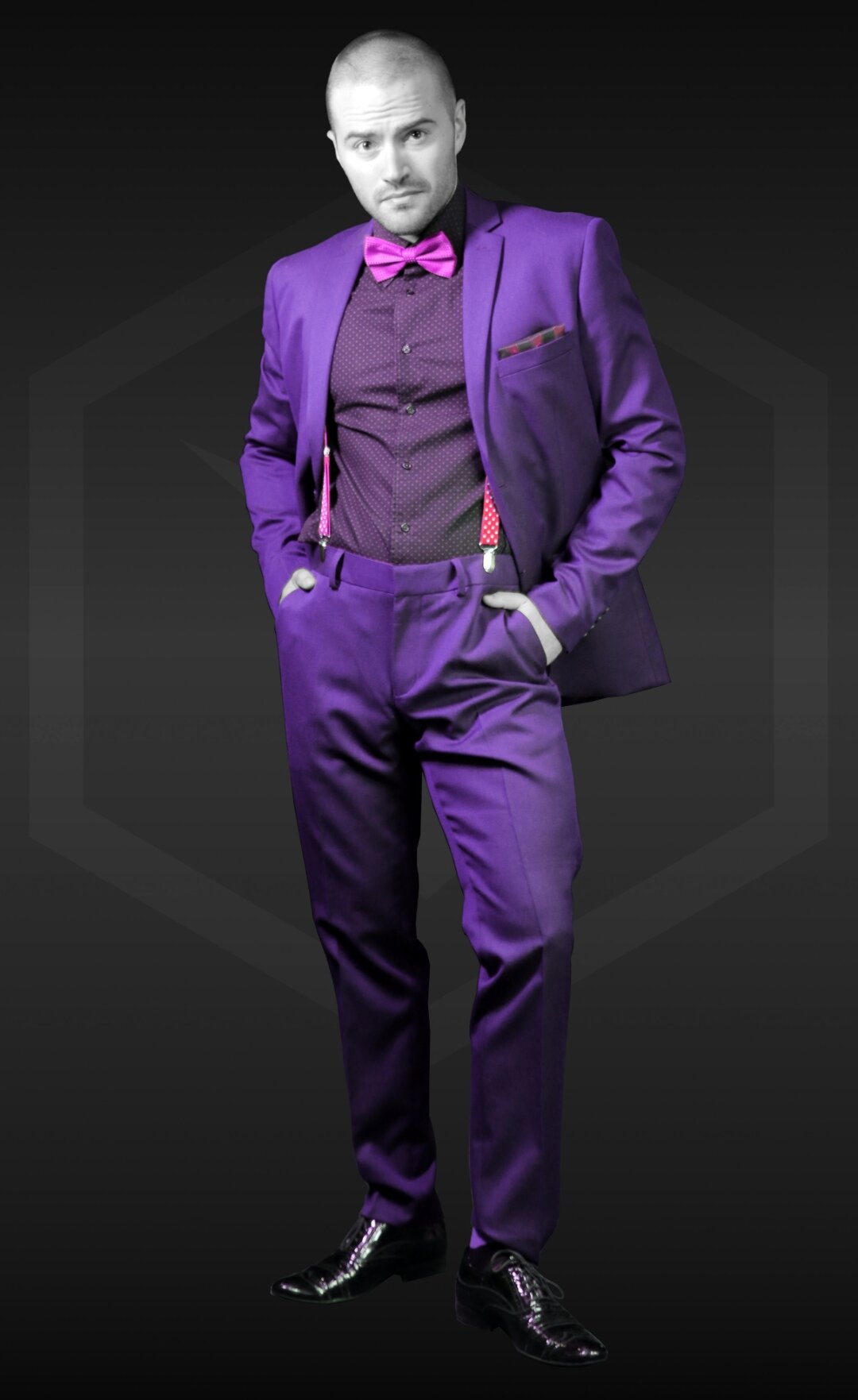What Does Wearing Purple Symbolize?
Anchored in history, purple was used to distinguish the wealthy from the common folk. This was largely due to the fact that the extraction process of that beautiful rich color took a longer amount of time, and as such, was only affordable and accessible to the wealthy.
However, a lot has changed since then: So what does wearing purple symbolize?
What Does Purple Symbolize?
Wearing purple symbolizes royalty, grandeur, independence, wisdom, devotion, extravagance, pride, and creativity, just to mention a few. And yes, the association with wealth is still made today. Beware though, for purple can also symbolize arrogance.
Some even believe that purple can also be associated with a higher sense of self, spirituality, and one’s alignment with the universe and what it represents.
Prime purple - more often called magenta - has many meanings that change depending on how the hue is shaded, tinted or toned.
On the inauguration day of President Joe Biden, Vice President Kamala Harris and many other women chose to wear purple outfits. They did so because the color purple symbolizes loyalty and trust. This comes from the association with royalty and power.
The color purple can be seen expressed in different forms and variations in nature. From the purple sea urchin in Mexico to some variant of cauliflower, this beautiful color graces nature in all its varied forms.
Unlike the other colors we've dealt with representing the emotions of anger or jealousy, purple is the color of mystery. How, you might ask?
Purple is derived from a purposeful mixture of blue and red; somehow, the calmness and boldness of each color compliment the other without the overwhelming distraction of standing out individually.
Each color you wear has its meaning and says something about the wearer. In the world of advertising and fashion, the color purple is seen as a soothing and vibrant color and usually symbolizes luxury as well as the expression of femininity in women. That said, how do we interpret purple?
OUR NEWEST ARTICLE:
The Meaning and Psychology behind Purple
What it means to clothe in the color purple has evolved over the years as people no longer predominantly associate the color with thoughts of royalty and the elite. However, regardless of how much the perception of the color has evolved, not much has changed in retrospect.
Purple as a color has a profound effect on how we perceive different feelings and emotions. People over the years have described the color as giving the feelings of mystery, spirituality, royalty, femininity, and even mourning. It is often seen as a rare and unique color, and this is largely due to the fact that it rarely occurs in nature.
Wearing purple can have a psychological effect as it possesses calming and stimulating properties, which benefits us by putting us in the right frame of mind. It could also decrease blood pressure and heart rate because of its bluish undertone.
The surreal suit. Yes, in this image we manipulated the colors. Nobody wears a purple outfit like this - unless you’re looking to stand out more than ever necessary!
According to sensationalcolor, it fosters creativity by awakening our senses while promoting the inner peace necessary to make intuitive, insightful observations. Purple creates a harmonious balance of awareness and peace.
In our previous post, we learned that in China, the color yellow was associated with wealth and grandeur, while in ancient Rome, it was the color purple that was worn by the elite. It goes without saying that different perceptions of the color purple have more to do with the culture of the people being asked, than anything else.
EFFECTS OF PURE PURPLE HUE (Magenta)
Prime Purple, more often actually called magenta, is purple in its purest and most saturated form. This is why it is so bright.
Traditional purple, like the color most of us identify as “purple” or “violet”, is actually a darkened version of prime purple (magenta). We’ll dig into this topic more in the following sections of this article.
The color purple in its purest and truest form (pure hue) is seen in many flowers. It is commonly associated with bubble gum, loyalty, mystery, imagination, energy, and creativity. As mentioned before, due to the fact that it was so hard to obtain the pigment, it was mostly used by the wealthy to show prominence.
This is the purple (or violet) we all know and love, isn’t it? Well, technically this is prime purple mixed with black…
Violet, or the darkened purple, as we mentioned before, is the classic color for royalty. Let’s just keep on talking about this version of “magenta” or “prime purple”, since it’s the one most people relate to.
From now on, let’s call this darker version of the prime “purple”.
Purple (the darker version), as a color being indicative of social status, wasn't just restricted to ancient times. On the contrary, it is tied to the perception of royalty carried on even to the late 20th century when it was seen as a color of choice to get tickets to Queen Elizabeth II’s coronation in 1953.
In terms of creativity and imagination, a study was carried out in 2005 about how the color of a questionnaire could affect survey response rates*, and the results showed that purple was the most effective color in both genders and across different age groups. People seemed to be more willing to properly answer the questions in a questionnaire if its color was purple.
Dreams and imagination are often associated with the color purple. It has even been said that using too much purple in advertising is bad because it can make the mind wander.
Purple is also the color of magic and mystery. Ever so often it has been used to represent magical happenings in media. When we think of what colors a magician wears we instantly think of black with dark red or… purple. See?
Incorporating purple in your clothing will make you appear regal and mysterious. People might actually be surprised due to the high confidence and prominence you exhume.
However, too much purple brings out the qualities of impatience, irritability, and arrogance. So, make sure to not overdo it.
In Thailand, purple is usually worn by widows in mourning. In the United States, the purple heart award is used to honor soldiers wounded in battle. As such, this color is preferably worn for more somber events.
What Does Purple Mean Sexually?
The sexual symbolism of purple is also something that is very culturally dependent. In the western world, the color purple symbolizes sexual frustration. This has to do with its association with royalty and mystery.
Now, this doesn’t mean you look bitter or sexually frustrated when you wear purple. It always depends on what kind of purple you wear.
As you’ll learn in the next few paragraphs, this magnificent color can have many different meanings depending on the amount of black, white, or gray added to it. Also, where you are in the world and which people you’re surrounded by change purple’s symbolism completely.
For instance, a muted, light purple has absolutely no connotation to sexual frustration in South America. In North America, on the other hand, the resulting color “old lavender” looks exactly as the name says: old (and maybe slightly frustrated).
Effects of Light And Dark Purples
DARK PURPLE Variants
Most commonly referred to as shades of purple are the darkened variants of the color purple. Dark purples are what you get when you mix purple with black. An example of this would be the powerful royal purple.
Dark purple is a stronger variant of purple that evokes intense emotions in both the wearer and observer. It can enhance feelings of gloom, sadness, and frustration. On the other hand, it also exudes much more power than the other variations of the color.
Some interesting facts: Purple (as a word) has been incorporated in wordplay. Purple is associated with other words in the production of meaning. For example, "Purple prose" is often used to refer to a highly imaginative literary work, while "purple haze" refers to euphoria or confusion, which might be drug-induced. It is even the color worn to create epilepsy awareness.
Dark purple is an elegant, yet mysterious color. Pair it with some bright and quirky elements and you can easily get rid of its connotation of sadness. | Socks: Shrooms
Apparently, purple even creates some sort of illusion as to how we imagine and perceive the world around us, rather than how the world really is.
It is truly the color of mystery and wearing purple (especially dark purple) symbolizes just that – albeit with a tinge of sadness mixed in.
LIGHT PURPLE Variations
A light purple hue is simply created by mixing purple with white at varying degrees, creating a tint. The more white is added, the lighter the final product.
Examples of light purple include lavender and lilac, which are considered "the grown-up pink".
Unlike dark purple, light purple or lilac is a rather feminine color.
The colors lilac and lavender offer the wearer the feeling of uniqueness, happiness, and a sense of being special without the intense mystery of saturated purple. They can even symbolize life and energy in some cultures.
Tinted Purple, due to its strong resemblance to the color pink, is also considered a feminine color, evoking the feeling of sensuality. In advertising, light purple is often used with pink to display feminine products.
Similarly, lighter purple tints are seen as a more mature color of choice as opposed to choosing pink.
If you’d like to know more about how dark or light clothing affect perception of the self, we suggest you read our article on the topic:
Purple Tones
When you mix gray and purple you get a purple tone. Depending on the amount of gray you add, the purple gets duller. Purple tones are rather uncommon - especially in clothing. They are simply not colors that look very good for (and on) most people.
It is generally not a good idea to wear a much unsaturated (grayed out) purple. The clothing you wear in these colors can seem cheap and just plain old. They have quite the opposite symbolism to life and energy.
If you are male, we suggest avoiding purple tones in your clothing altogether. If you’re female though, a tad of unsaturated purple can even look interesting. Try it out and find out for yourself. You might like what you see.
The Color Purple in a Nutshell
What does wearing purple symbolize? Purple is a color that is as complex as it is anchored in history. Regardless of the fact that times have changed (and so has fashion), it is still often associated with royalty and social prominence. And yet, wearing too much of the color might make you seem arrogant
Purple enhances the imagination and creativity. In crystal therapy, purple amethyst is used to unblock creativity, increase imagination, remove spiritual obstacles, and reawaken the learning of new things. However, too much creativity increases feelings of moodiness.
Even in mainstream media, purple is often used to depict magic and mystery in movie scenes, in theaters, at concerts, and well, basically everywhere suitable.
Purple is definitely a very versatile color. It is regal, mysterious, and much more.
INTERESTING SUGGESTIONS:















